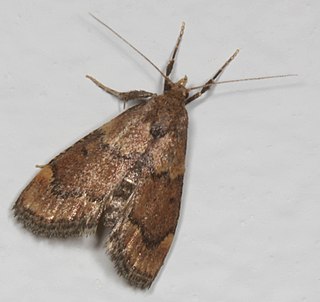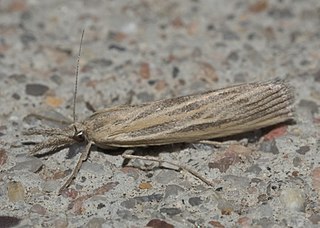Anatralata is a genus of moths of the family Crambidae. It contains only one species, Anatralata versicolor, which is found in North America, where it has been recorded from California to Idaho and British Columbia. The habitat consists of mountainous areas and low-elevation grasslands along the coast of central California.
Arequipa is a genus of moths of the family Crambidae. It contains only one species, Arequipa turbatella, which is found in North America, where it has been recorded from Alabama, Illinois, Maine, Maryland, North Carolina, Ohio, Ontario, Pennsylvania, Quebec and West Virginia.
Langessa is a genus of moths of the family Crambidae. It contains only one species, Langessa nomophilalis, the black langessa moth, which is found in North America, where it has been recorded from Alabama, Florida and South Carolina.
Nannobotys is a genus of moths of the family Crambidae. It contains only one species, Nannobotys commortalis, which is found in North America, where it has been recorded from eastern Washington to California and Nevada.

Niphograpta is a genus of moths of the family Crambidae. It contains only one species, the water hyacinth moth. It is native to the Amazon basin, but has been introduced in North America, Africa and Australia to control the spread of water hyacinth.
Odontivalvia is a genus of moths of the family Crambidae. It contains only one species, Odontivalvia radialis, which is found in North America, where it has been recorded from Texas.

Pseudoschinia is a genus of moths of the family Crambidae. It contains only one species, Pseudoschinia elautalis, which is found in North America, where it has been recorded from Arizona, California, Nevada, New Mexico and Texas.

Perispasta is a genus of moths of the family Crambidae. It contains only one species, Perispasta caeculalis, or Titian Peale's pyralid moth, which is found in North America, where it has been recorded from Quebec west to British Columbia, south to Florida, Texas and Colorado. The habitat consists of fields and meadows. Both the genus and species were first described by Philipp Christoph Zeller in 1875.
Raphiptera is a genus of moths of the family Crambidae. It contains only one species, Raphiptera argillaceellus, the diminutive grass-veneer, which is found in eastern North America, where it has been recorded from Labrador, Ontario, Wisconsin, Connecticut, New York, Quebec, Alberta and Michigan. The range extends to Florida and Texas in the south-east and Costa Rica in Central America. The habitat consists of bogs.

Pococera robustella, the pine webworm moth, is a species of moth of the family Pyralidae. It is found in southern Canada and the eastern United States from Minnesota to New England and south to Florida.

Dioryctria albovittella, the pinyon tip moth, is a species of moth of the family Pyralidae. It is found in North America including New Mexico.

Dioryctria ebeli, the south coastal coneworm moth, is a species of moth of the family Pyralidae. It is found in the US states of Florida, the southern parts of South Carolina, Georgia, Alabama, Massachusetts, and south-eastern Louisiana.

Dioryctria amatella, the southern pineconeworm moth, is a species of moth of the family Pyralidae. It is found in the south-eastern United States, from Maryland south to Florida and west into Texas.

Dioryctria disclusa, the webbing coneworm or rusty pine cone moth, is a species of moth of the family Pyralidae. It is found in North America from New Brunswick to Florida, west to Texas and north to Manitoba.

Hypsopygia phoezalis is a species of snout moth in the genus Hypsopygia. It is found near Los Angeles and Catalina Island in California.

Palpita gracialis, the gracile palpita moth, is a moth of the family Crambidae. It is found in North America, from California to Texas and Oklahoma.

Thaumatopsis pexellus, the woolly grass-veneer, is a moth in the family Crambidae. It was described by Philipp Christoph Zeller in 1863. It is found in most of North America. The habitat consists of grasslands.
Dichogama colotha is a moth in the family Crambidae. It is found in Costa Rica, Mexico and the United States, where it has been recorded from Texas. It is also found in Puerto Rico.

Pyrausta unifascialis, the one-banded pyrausta, is a moth in the family Crambidae. It was described by Alpheus Spring Packard in 1873. It is found in North America, where it has been recorded from Quebec west to British Columbia, south to Arizona and California. The habitat consists of forest openings, clearings and fields.

Palpita quadristigmalis, the four-spotted palpita moth, is a moth in the family Crambidae. It is found in North America, where it has been recorded from Quebec and Ontario to Florida, west to Arizona and north to Colorado.














